CNA151 Assessment Task 2 Report: Health Determinants and Solutions
VerifiedAdded on 2022/09/15
|10
|2343
|20
Report
AI Summary
This report examines the socio-demographic characteristics and social determinants of health of a case study involving a 54-year-old woman named Carla, focusing on her life in a rural mining town, her education, employment, and family circumstances. The report identifies key social determinants such as education, employment, and income, and their impact on the individuals in the case study, linking these factors to health outcomes. The report then proposes strategies to address the social determinant of education at a population level, including investment in education and promoting awareness. Finally, it explores the roles of health professionals, including nurses and doctors, in addressing social determinants through interventions, counseling, and collaboration, emphasizing the importance of compassionate care and psychological support.
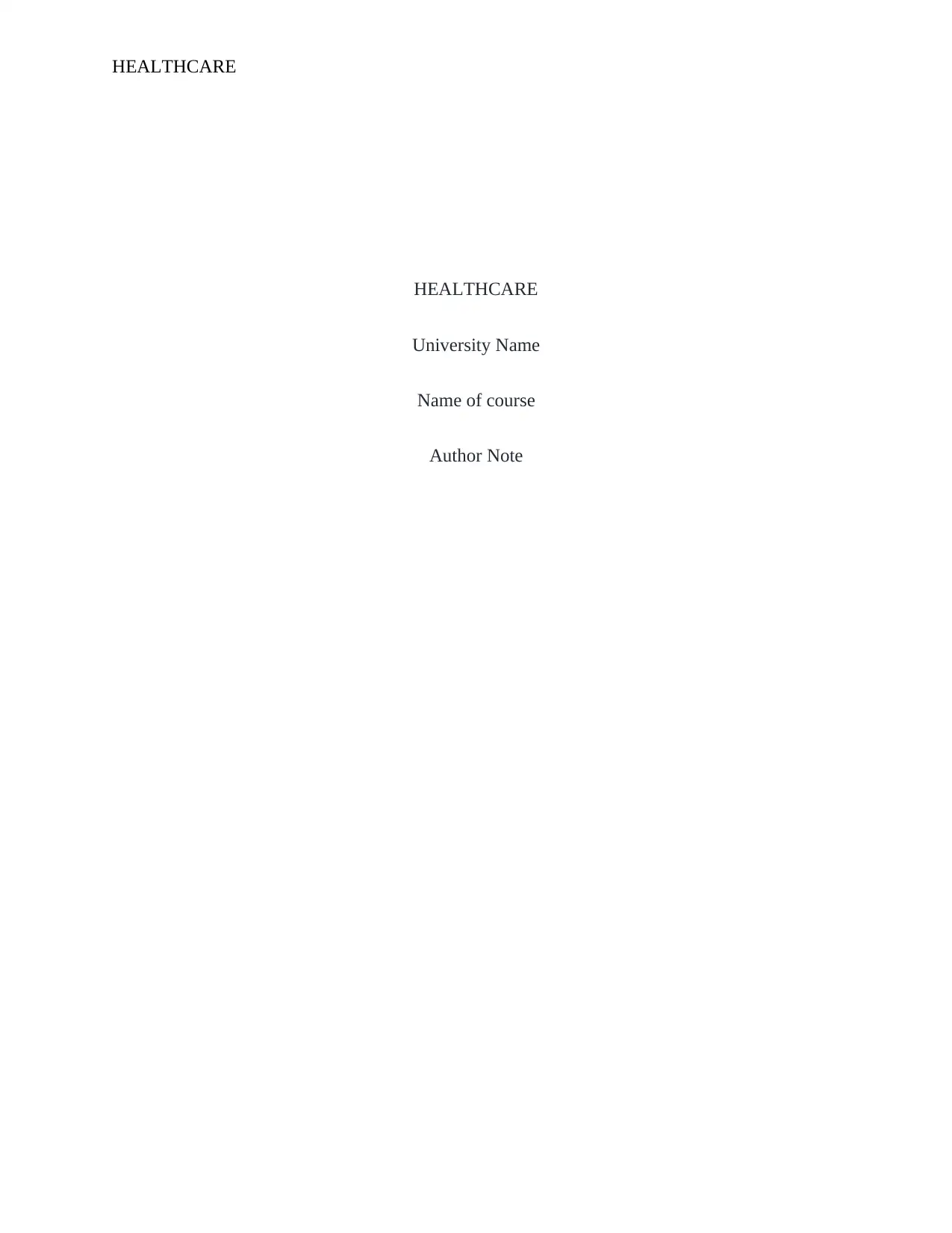
HEALTHCARE
HEALTHCARE
University Name
Name of course
Author Note
HEALTHCARE
University Name
Name of course
Author Note
Paraphrase This Document
Need a fresh take? Get an instant paraphrase of this document with our AI Paraphraser
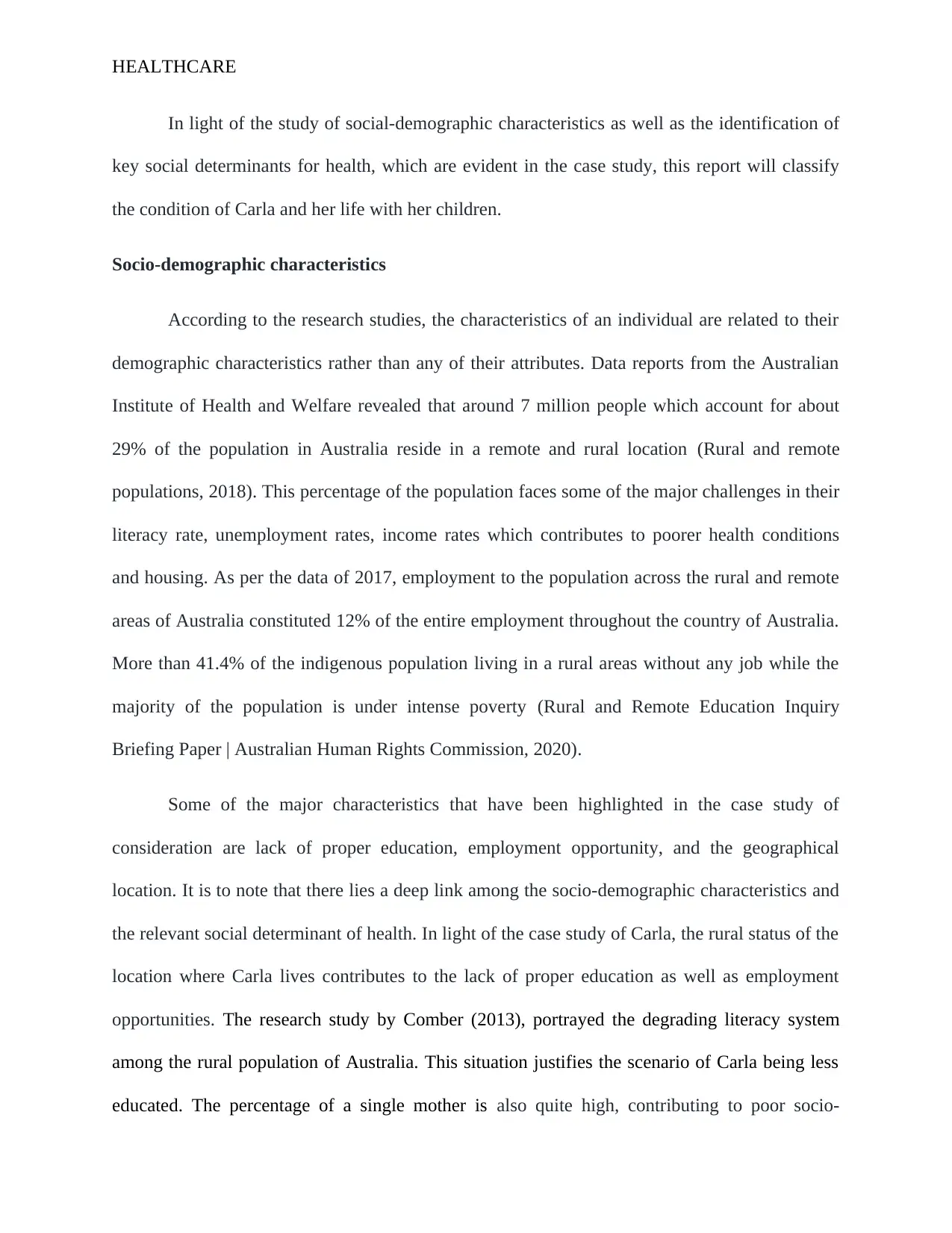
HEALTHCARE
In light of the study of social-demographic characteristics as well as the identification of
key social determinants for health, which are evident in the case study, this report will classify
the condition of Carla and her life with her children.
Socio-demographic characteristics
According to the research studies, the characteristics of an individual are related to their
demographic characteristics rather than any of their attributes. Data reports from the Australian
Institute of Health and Welfare revealed that around 7 million people which account for about
29% of the population in Australia reside in a remote and rural location (Rural and remote
populations, 2018). This percentage of the population faces some of the major challenges in their
literacy rate, unemployment rates, income rates which contributes to poorer health conditions
and housing. As per the data of 2017, employment to the population across the rural and remote
areas of Australia constituted 12% of the entire employment throughout the country of Australia.
More than 41.4% of the indigenous population living in a rural areas without any job while the
majority of the population is under intense poverty (Rural and Remote Education Inquiry
Briefing Paper | Australian Human Rights Commission, 2020).
Some of the major characteristics that have been highlighted in the case study of
consideration are lack of proper education, employment opportunity, and the geographical
location. It is to note that there lies a deep link among the socio-demographic characteristics and
the relevant social determinant of health. In light of the case study of Carla, the rural status of the
location where Carla lives contributes to the lack of proper education as well as employment
opportunities. The research study by Comber (2013), portrayed the degrading literacy system
among the rural population of Australia. This situation justifies the scenario of Carla being less
educated. The percentage of a single mother is also quite high, contributing to poor socio-
In light of the study of social-demographic characteristics as well as the identification of
key social determinants for health, which are evident in the case study, this report will classify
the condition of Carla and her life with her children.
Socio-demographic characteristics
According to the research studies, the characteristics of an individual are related to their
demographic characteristics rather than any of their attributes. Data reports from the Australian
Institute of Health and Welfare revealed that around 7 million people which account for about
29% of the population in Australia reside in a remote and rural location (Rural and remote
populations, 2018). This percentage of the population faces some of the major challenges in their
literacy rate, unemployment rates, income rates which contributes to poorer health conditions
and housing. As per the data of 2017, employment to the population across the rural and remote
areas of Australia constituted 12% of the entire employment throughout the country of Australia.
More than 41.4% of the indigenous population living in a rural areas without any job while the
majority of the population is under intense poverty (Rural and Remote Education Inquiry
Briefing Paper | Australian Human Rights Commission, 2020).
Some of the major characteristics that have been highlighted in the case study of
consideration are lack of proper education, employment opportunity, and the geographical
location. It is to note that there lies a deep link among the socio-demographic characteristics and
the relevant social determinant of health. In light of the case study of Carla, the rural status of the
location where Carla lives contributes to the lack of proper education as well as employment
opportunities. The research study by Comber (2013), portrayed the degrading literacy system
among the rural population of Australia. This situation justifies the scenario of Carla being less
educated. The percentage of a single mother is also quite high, contributing to poor socio-
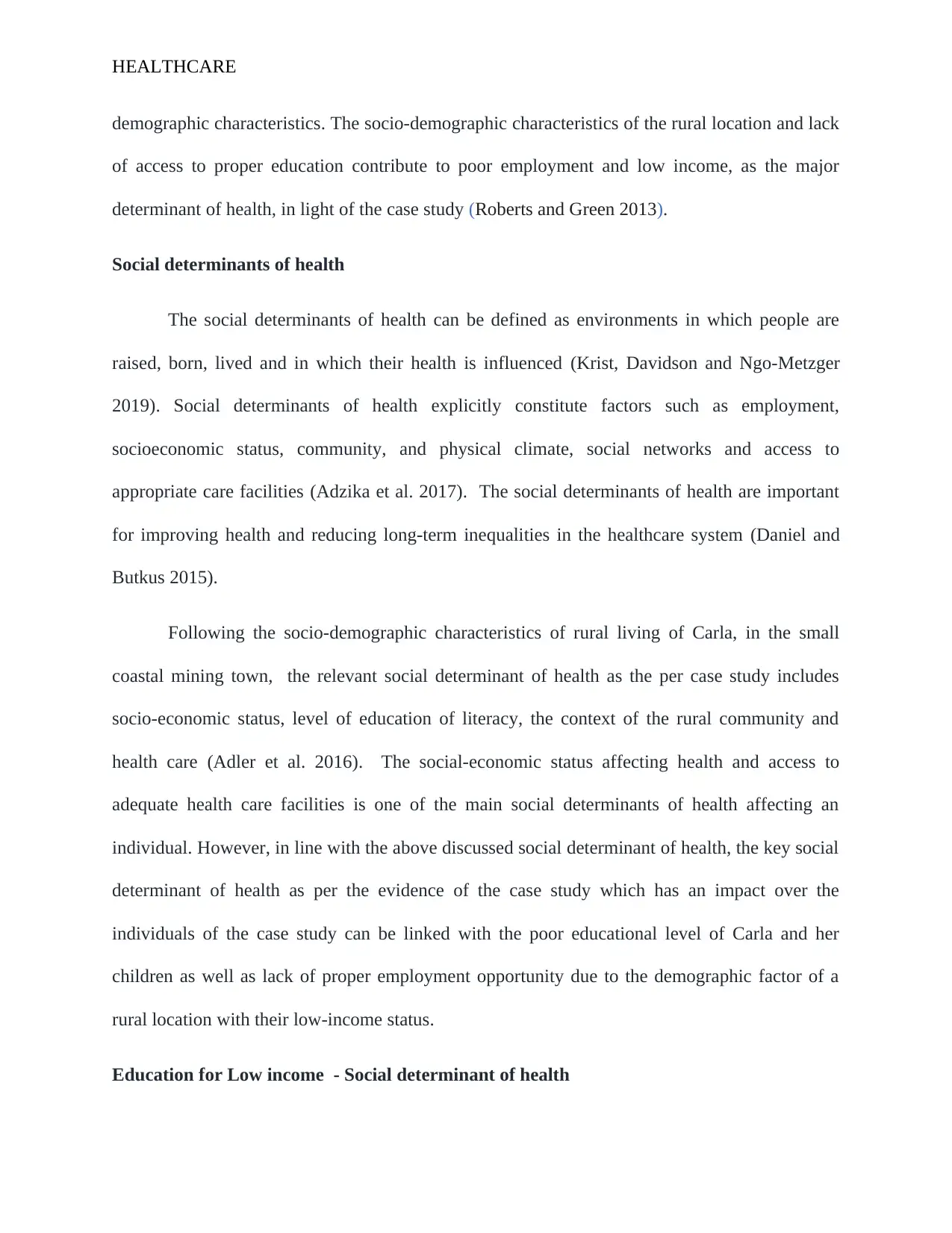
HEALTHCARE
demographic characteristics. The socio-demographic characteristics of the rural location and lack
of access to proper education contribute to poor employment and low income, as the major
determinant of health, in light of the case study (Roberts and Green 2013).
Social determinants of health
The social determinants of health can be defined as environments in which people are
raised, born, lived and in which their health is influenced (Krist, Davidson and Ngo-Metzger
2019). Social determinants of health explicitly constitute factors such as employment,
socioeconomic status, community, and physical climate, social networks and access to
appropriate care facilities (Adzika et al. 2017). The social determinants of health are important
for improving health and reducing long-term inequalities in the healthcare system (Daniel and
Butkus 2015).
Following the socio-demographic characteristics of rural living of Carla, in the small
coastal mining town, the relevant social determinant of health as the per case study includes
socio-economic status, level of education of literacy, the context of the rural community and
health care (Adler et al. 2016). The social-economic status affecting health and access to
adequate health care facilities is one of the main social determinants of health affecting an
individual. However, in line with the above discussed social determinant of health, the key social
determinant of health as per the evidence of the case study which has an impact over the
individuals of the case study can be linked with the poor educational level of Carla and her
children as well as lack of proper employment opportunity due to the demographic factor of a
rural location with their low-income status.
Education for Low income - Social determinant of health
demographic characteristics. The socio-demographic characteristics of the rural location and lack
of access to proper education contribute to poor employment and low income, as the major
determinant of health, in light of the case study (Roberts and Green 2013).
Social determinants of health
The social determinants of health can be defined as environments in which people are
raised, born, lived and in which their health is influenced (Krist, Davidson and Ngo-Metzger
2019). Social determinants of health explicitly constitute factors such as employment,
socioeconomic status, community, and physical climate, social networks and access to
appropriate care facilities (Adzika et al. 2017). The social determinants of health are important
for improving health and reducing long-term inequalities in the healthcare system (Daniel and
Butkus 2015).
Following the socio-demographic characteristics of rural living of Carla, in the small
coastal mining town, the relevant social determinant of health as the per case study includes
socio-economic status, level of education of literacy, the context of the rural community and
health care (Adler et al. 2016). The social-economic status affecting health and access to
adequate health care facilities is one of the main social determinants of health affecting an
individual. However, in line with the above discussed social determinant of health, the key social
determinant of health as per the evidence of the case study which has an impact over the
individuals of the case study can be linked with the poor educational level of Carla and her
children as well as lack of proper employment opportunity due to the demographic factor of a
rural location with their low-income status.
Education for Low income - Social determinant of health
⊘ This is a preview!⊘
Do you want full access?
Subscribe today to unlock all pages.

Trusted by 1+ million students worldwide
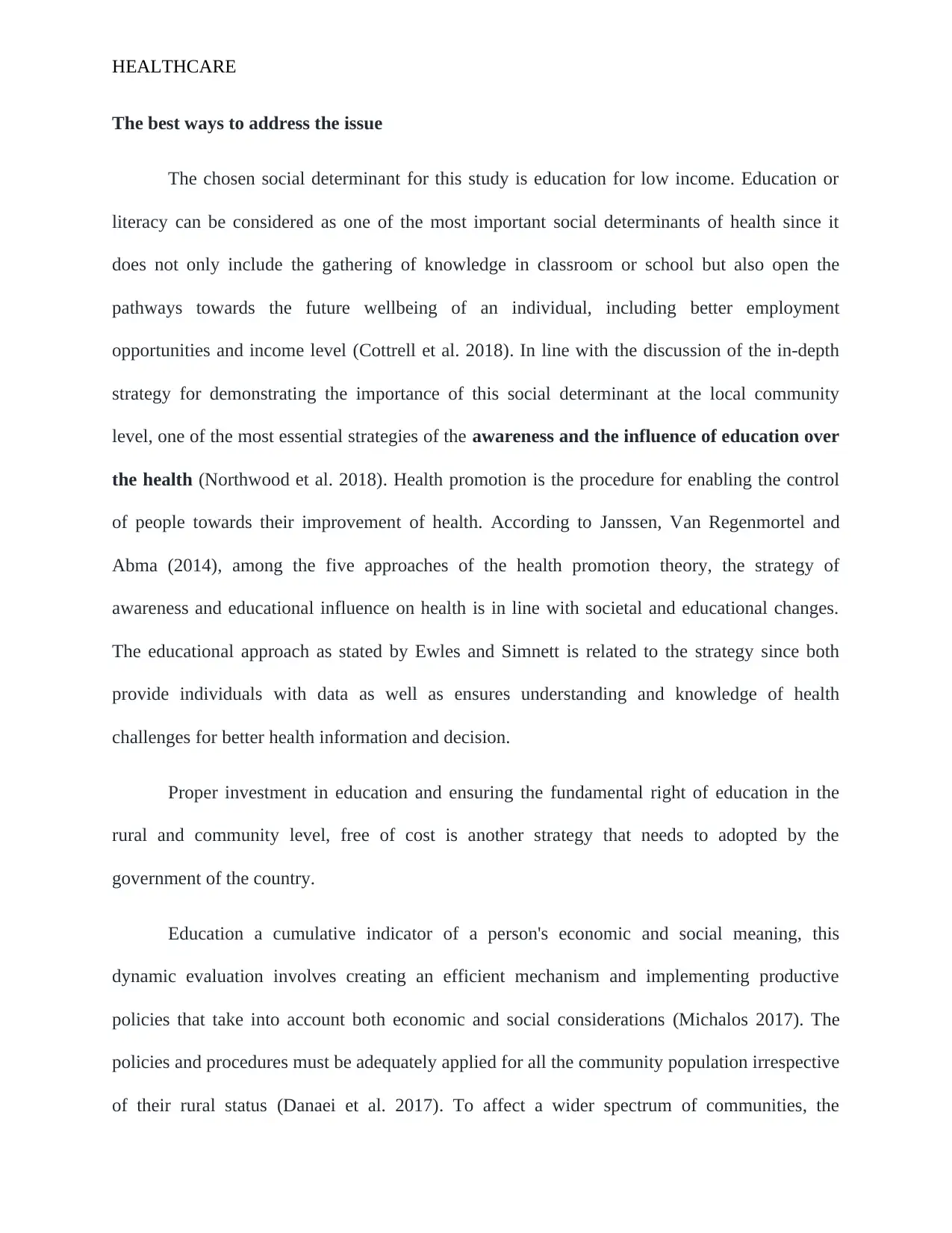
HEALTHCARE
The best ways to address the issue
The chosen social determinant for this study is education for low income. Education or
literacy can be considered as one of the most important social determinants of health since it
does not only include the gathering of knowledge in classroom or school but also open the
pathways towards the future wellbeing of an individual, including better employment
opportunities and income level (Cottrell et al. 2018). In line with the discussion of the in-depth
strategy for demonstrating the importance of this social determinant at the local community
level, one of the most essential strategies of the awareness and the influence of education over
the health (Northwood et al. 2018). Health promotion is the procedure for enabling the control
of people towards their improvement of health. According to Janssen, Van Regenmortel and
Abma (2014), among the five approaches of the health promotion theory, the strategy of
awareness and educational influence on health is in line with societal and educational changes.
The educational approach as stated by Ewles and Simnett is related to the strategy since both
provide individuals with data as well as ensures understanding and knowledge of health
challenges for better health information and decision.
Proper investment in education and ensuring the fundamental right of education in the
rural and community level, free of cost is another strategy that needs to adopted by the
government of the country.
Education a cumulative indicator of a person's economic and social meaning, this
dynamic evaluation involves creating an efficient mechanism and implementing productive
policies that take into account both economic and social considerations (Michalos 2017). The
policies and procedures must be adequately applied for all the community population irrespective
of their rural status (Danaei et al. 2017). To affect a wider spectrum of communities, the
The best ways to address the issue
The chosen social determinant for this study is education for low income. Education or
literacy can be considered as one of the most important social determinants of health since it
does not only include the gathering of knowledge in classroom or school but also open the
pathways towards the future wellbeing of an individual, including better employment
opportunities and income level (Cottrell et al. 2018). In line with the discussion of the in-depth
strategy for demonstrating the importance of this social determinant at the local community
level, one of the most essential strategies of the awareness and the influence of education over
the health (Northwood et al. 2018). Health promotion is the procedure for enabling the control
of people towards their improvement of health. According to Janssen, Van Regenmortel and
Abma (2014), among the five approaches of the health promotion theory, the strategy of
awareness and educational influence on health is in line with societal and educational changes.
The educational approach as stated by Ewles and Simnett is related to the strategy since both
provide individuals with data as well as ensures understanding and knowledge of health
challenges for better health information and decision.
Proper investment in education and ensuring the fundamental right of education in the
rural and community level, free of cost is another strategy that needs to adopted by the
government of the country.
Education a cumulative indicator of a person's economic and social meaning, this
dynamic evaluation involves creating an efficient mechanism and implementing productive
policies that take into account both economic and social considerations (Michalos 2017). The
policies and procedures must be adequately applied for all the community population irrespective
of their rural status (Danaei et al. 2017). To affect a wider spectrum of communities, the
Paraphrase This Document
Need a fresh take? Get an instant paraphrase of this document with our AI Paraphraser
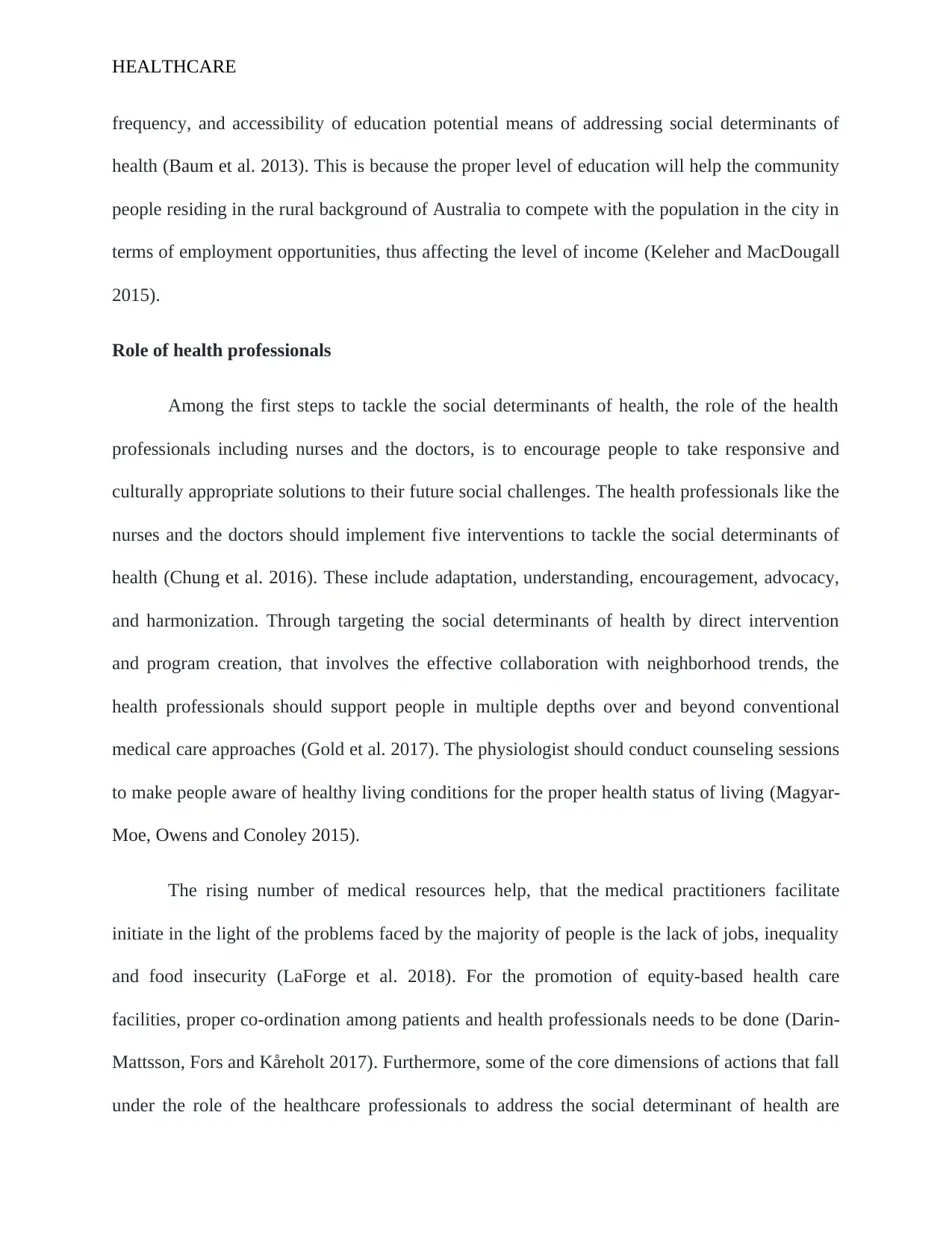
HEALTHCARE
frequency, and accessibility of education potential means of addressing social determinants of
health (Baum et al. 2013). This is because the proper level of education will help the community
people residing in the rural background of Australia to compete with the population in the city in
terms of employment opportunities, thus affecting the level of income (Keleher and MacDougall
2015).
Role of health professionals
Among the first steps to tackle the social determinants of health, the role of the health
professionals including nurses and the doctors, is to encourage people to take responsive and
culturally appropriate solutions to their future social challenges. The health professionals like the
nurses and the doctors should implement five interventions to tackle the social determinants of
health (Chung et al. 2016). These include adaptation, understanding, encouragement, advocacy,
and harmonization. Through targeting the social determinants of health by direct intervention
and program creation, that involves the effective collaboration with neighborhood trends, the
health professionals should support people in multiple depths over and beyond conventional
medical care approaches (Gold et al. 2017). The physiologist should conduct counseling sessions
to make people aware of healthy living conditions for the proper health status of living (Magyar-
Moe, Owens and Conoley 2015).
The rising number of medical resources help, that the medical practitioners facilitate
initiate in the light of the problems faced by the majority of people is the lack of jobs, inequality
and food insecurity (LaForge et al. 2018). For the promotion of equity-based health care
facilities, proper co-ordination among patients and health professionals needs to be done (Darin-
Mattsson, Fors and Kåreholt 2017). Furthermore, some of the core dimensions of actions that fall
under the role of the healthcare professionals to address the social determinant of health are
frequency, and accessibility of education potential means of addressing social determinants of
health (Baum et al. 2013). This is because the proper level of education will help the community
people residing in the rural background of Australia to compete with the population in the city in
terms of employment opportunities, thus affecting the level of income (Keleher and MacDougall
2015).
Role of health professionals
Among the first steps to tackle the social determinants of health, the role of the health
professionals including nurses and the doctors, is to encourage people to take responsive and
culturally appropriate solutions to their future social challenges. The health professionals like the
nurses and the doctors should implement five interventions to tackle the social determinants of
health (Chung et al. 2016). These include adaptation, understanding, encouragement, advocacy,
and harmonization. Through targeting the social determinants of health by direct intervention
and program creation, that involves the effective collaboration with neighborhood trends, the
health professionals should support people in multiple depths over and beyond conventional
medical care approaches (Gold et al. 2017). The physiologist should conduct counseling sessions
to make people aware of healthy living conditions for the proper health status of living (Magyar-
Moe, Owens and Conoley 2015).
The rising number of medical resources help, that the medical practitioners facilitate
initiate in the light of the problems faced by the majority of people is the lack of jobs, inequality
and food insecurity (LaForge et al. 2018). For the promotion of equity-based health care
facilities, proper co-ordination among patients and health professionals needs to be done (Darin-
Mattsson, Fors and Kåreholt 2017). Furthermore, some of the core dimensions of actions that fall
under the role of the healthcare professionals to address the social determinant of health are
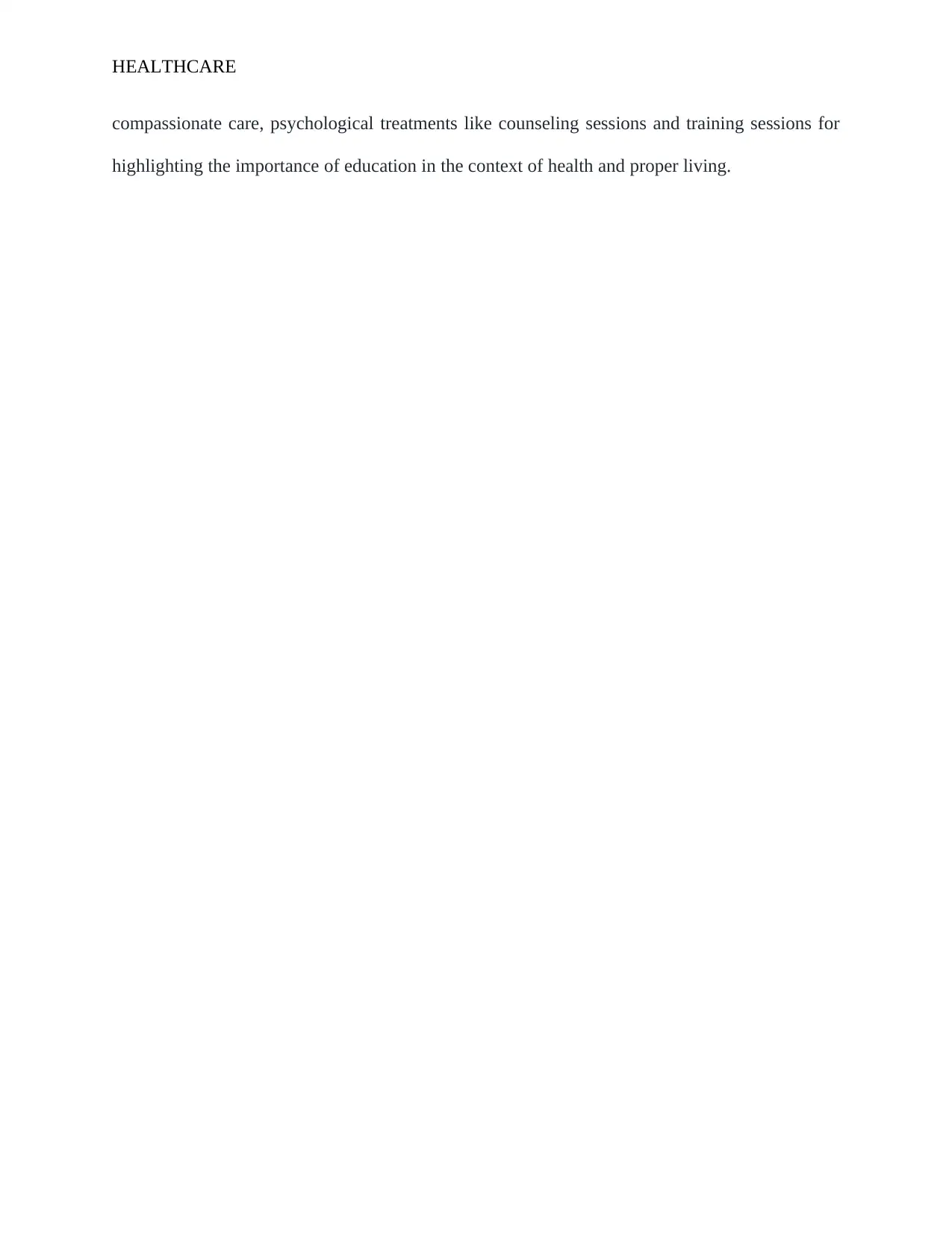
HEALTHCARE
compassionate care, psychological treatments like counseling sessions and training sessions for
highlighting the importance of education in the context of health and proper living.
compassionate care, psychological treatments like counseling sessions and training sessions for
highlighting the importance of education in the context of health and proper living.
⊘ This is a preview!⊘
Do you want full access?
Subscribe today to unlock all pages.

Trusted by 1+ million students worldwide
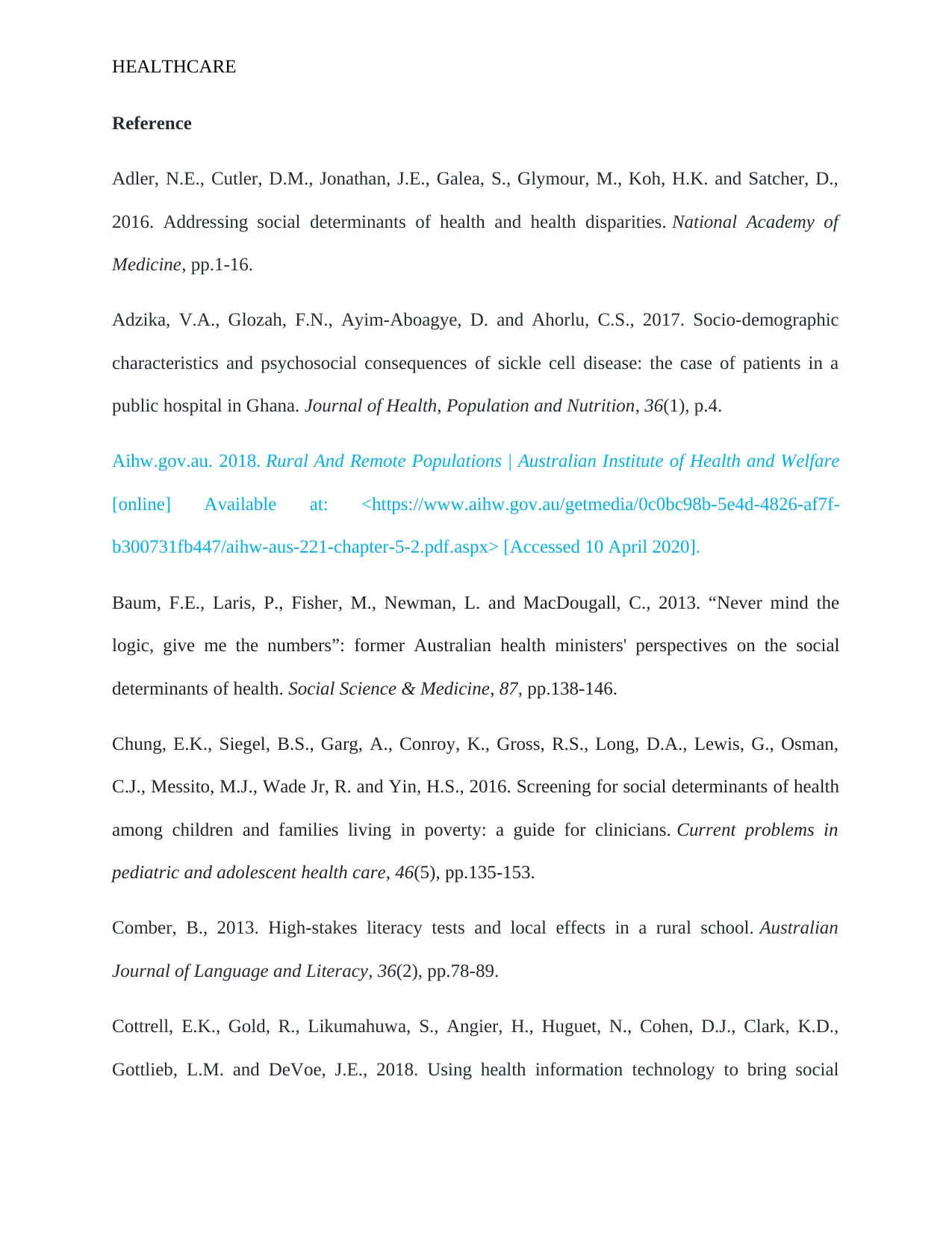
HEALTHCARE
Reference
Adler, N.E., Cutler, D.M., Jonathan, J.E., Galea, S., Glymour, M., Koh, H.K. and Satcher, D.,
2016. Addressing social determinants of health and health disparities. National Academy of
Medicine, pp.1-16.
Adzika, V.A., Glozah, F.N., Ayim-Aboagye, D. and Ahorlu, C.S., 2017. Socio-demographic
characteristics and psychosocial consequences of sickle cell disease: the case of patients in a
public hospital in Ghana. Journal of Health, Population and Nutrition, 36(1), p.4.
Aihw.gov.au. 2018. Rural And Remote Populations | Australian Institute of Health and Welfare
[online] Available at: <https://www.aihw.gov.au/getmedia/0c0bc98b-5e4d-4826-af7f-
b300731fb447/aihw-aus-221-chapter-5-2.pdf.aspx> [Accessed 10 April 2020].
Baum, F.E., Laris, P., Fisher, M., Newman, L. and MacDougall, C., 2013. “Never mind the
logic, give me the numbers”: former Australian health ministers' perspectives on the social
determinants of health. Social Science & Medicine, 87, pp.138-146.
Chung, E.K., Siegel, B.S., Garg, A., Conroy, K., Gross, R.S., Long, D.A., Lewis, G., Osman,
C.J., Messito, M.J., Wade Jr, R. and Yin, H.S., 2016. Screening for social determinants of health
among children and families living in poverty: a guide for clinicians. Current problems in
pediatric and adolescent health care, 46(5), pp.135-153.
Comber, B., 2013. High-stakes literacy tests and local effects in a rural school. Australian
Journal of Language and Literacy, 36(2), pp.78-89.
Cottrell, E.K., Gold, R., Likumahuwa, S., Angier, H., Huguet, N., Cohen, D.J., Clark, K.D.,
Gottlieb, L.M. and DeVoe, J.E., 2018. Using health information technology to bring social
Reference
Adler, N.E., Cutler, D.M., Jonathan, J.E., Galea, S., Glymour, M., Koh, H.K. and Satcher, D.,
2016. Addressing social determinants of health and health disparities. National Academy of
Medicine, pp.1-16.
Adzika, V.A., Glozah, F.N., Ayim-Aboagye, D. and Ahorlu, C.S., 2017. Socio-demographic
characteristics and psychosocial consequences of sickle cell disease: the case of patients in a
public hospital in Ghana. Journal of Health, Population and Nutrition, 36(1), p.4.
Aihw.gov.au. 2018. Rural And Remote Populations | Australian Institute of Health and Welfare
[online] Available at: <https://www.aihw.gov.au/getmedia/0c0bc98b-5e4d-4826-af7f-
b300731fb447/aihw-aus-221-chapter-5-2.pdf.aspx> [Accessed 10 April 2020].
Baum, F.E., Laris, P., Fisher, M., Newman, L. and MacDougall, C., 2013. “Never mind the
logic, give me the numbers”: former Australian health ministers' perspectives on the social
determinants of health. Social Science & Medicine, 87, pp.138-146.
Chung, E.K., Siegel, B.S., Garg, A., Conroy, K., Gross, R.S., Long, D.A., Lewis, G., Osman,
C.J., Messito, M.J., Wade Jr, R. and Yin, H.S., 2016. Screening for social determinants of health
among children and families living in poverty: a guide for clinicians. Current problems in
pediatric and adolescent health care, 46(5), pp.135-153.
Comber, B., 2013. High-stakes literacy tests and local effects in a rural school. Australian
Journal of Language and Literacy, 36(2), pp.78-89.
Cottrell, E.K., Gold, R., Likumahuwa, S., Angier, H., Huguet, N., Cohen, D.J., Clark, K.D.,
Gottlieb, L.M. and DeVoe, J.E., 2018. Using health information technology to bring social
Paraphrase This Document
Need a fresh take? Get an instant paraphrase of this document with our AI Paraphraser
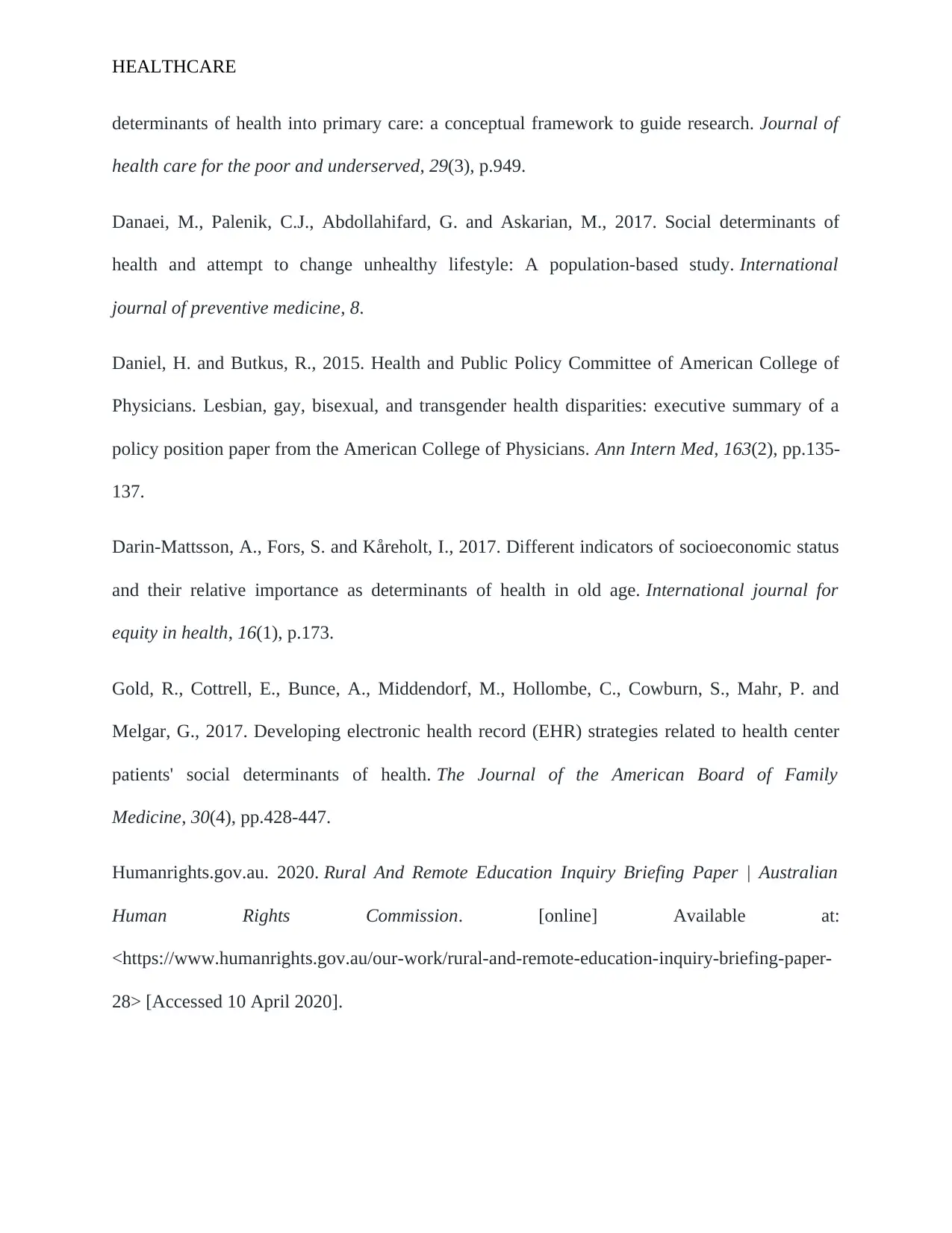
HEALTHCARE
determinants of health into primary care: a conceptual framework to guide research. Journal of
health care for the poor and underserved, 29(3), p.949.
Danaei, M., Palenik, C.J., Abdollahifard, G. and Askarian, M., 2017. Social determinants of
health and attempt to change unhealthy lifestyle: A population-based study. International
journal of preventive medicine, 8.
Daniel, H. and Butkus, R., 2015. Health and Public Policy Committee of American College of
Physicians. Lesbian, gay, bisexual, and transgender health disparities: executive summary of a
policy position paper from the American College of Physicians. Ann Intern Med, 163(2), pp.135-
137.
Darin-Mattsson, A., Fors, S. and Kåreholt, I., 2017. Different indicators of socioeconomic status
and their relative importance as determinants of health in old age. International journal for
equity in health, 16(1), p.173.
Gold, R., Cottrell, E., Bunce, A., Middendorf, M., Hollombe, C., Cowburn, S., Mahr, P. and
Melgar, G., 2017. Developing electronic health record (EHR) strategies related to health center
patients' social determinants of health. The Journal of the American Board of Family
Medicine, 30(4), pp.428-447.
Humanrights.gov.au. 2020. Rural And Remote Education Inquiry Briefing Paper | Australian
Human Rights Commission. [online] Available at:
<https://www.humanrights.gov.au/our-work/rural-and-remote-education-inquiry-briefing-paper-
28> [Accessed 10 April 2020].
determinants of health into primary care: a conceptual framework to guide research. Journal of
health care for the poor and underserved, 29(3), p.949.
Danaei, M., Palenik, C.J., Abdollahifard, G. and Askarian, M., 2017. Social determinants of
health and attempt to change unhealthy lifestyle: A population-based study. International
journal of preventive medicine, 8.
Daniel, H. and Butkus, R., 2015. Health and Public Policy Committee of American College of
Physicians. Lesbian, gay, bisexual, and transgender health disparities: executive summary of a
policy position paper from the American College of Physicians. Ann Intern Med, 163(2), pp.135-
137.
Darin-Mattsson, A., Fors, S. and Kåreholt, I., 2017. Different indicators of socioeconomic status
and their relative importance as determinants of health in old age. International journal for
equity in health, 16(1), p.173.
Gold, R., Cottrell, E., Bunce, A., Middendorf, M., Hollombe, C., Cowburn, S., Mahr, P. and
Melgar, G., 2017. Developing electronic health record (EHR) strategies related to health center
patients' social determinants of health. The Journal of the American Board of Family
Medicine, 30(4), pp.428-447.
Humanrights.gov.au. 2020. Rural And Remote Education Inquiry Briefing Paper | Australian
Human Rights Commission. [online] Available at:
<https://www.humanrights.gov.au/our-work/rural-and-remote-education-inquiry-briefing-paper-
28> [Accessed 10 April 2020].
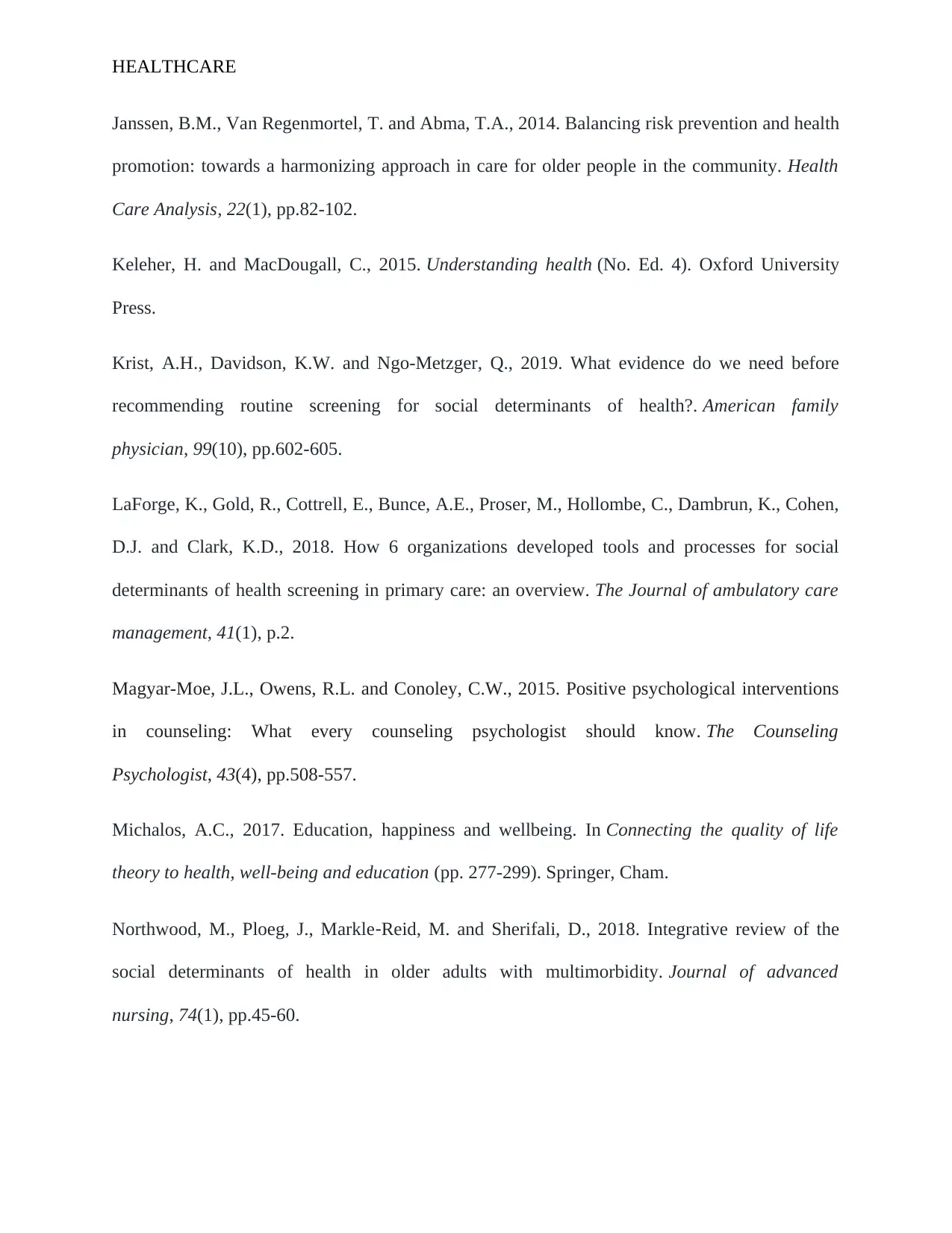
HEALTHCARE
Janssen, B.M., Van Regenmortel, T. and Abma, T.A., 2014. Balancing risk prevention and health
promotion: towards a harmonizing approach in care for older people in the community. Health
Care Analysis, 22(1), pp.82-102.
Keleher, H. and MacDougall, C., 2015. Understanding health (No. Ed. 4). Oxford University
Press.
Krist, A.H., Davidson, K.W. and Ngo-Metzger, Q., 2019. What evidence do we need before
recommending routine screening for social determinants of health?. American family
physician, 99(10), pp.602-605.
LaForge, K., Gold, R., Cottrell, E., Bunce, A.E., Proser, M., Hollombe, C., Dambrun, K., Cohen,
D.J. and Clark, K.D., 2018. How 6 organizations developed tools and processes for social
determinants of health screening in primary care: an overview. The Journal of ambulatory care
management, 41(1), p.2.
Magyar-Moe, J.L., Owens, R.L. and Conoley, C.W., 2015. Positive psychological interventions
in counseling: What every counseling psychologist should know. The Counseling
Psychologist, 43(4), pp.508-557.
Michalos, A.C., 2017. Education, happiness and wellbeing. In Connecting the quality of life
theory to health, well-being and education (pp. 277-299). Springer, Cham.
Northwood, M., Ploeg, J., Markle‐Reid, M. and Sherifali, D., 2018. Integrative review of the
social determinants of health in older adults with multimorbidity. Journal of advanced
nursing, 74(1), pp.45-60.
Janssen, B.M., Van Regenmortel, T. and Abma, T.A., 2014. Balancing risk prevention and health
promotion: towards a harmonizing approach in care for older people in the community. Health
Care Analysis, 22(1), pp.82-102.
Keleher, H. and MacDougall, C., 2015. Understanding health (No. Ed. 4). Oxford University
Press.
Krist, A.H., Davidson, K.W. and Ngo-Metzger, Q., 2019. What evidence do we need before
recommending routine screening for social determinants of health?. American family
physician, 99(10), pp.602-605.
LaForge, K., Gold, R., Cottrell, E., Bunce, A.E., Proser, M., Hollombe, C., Dambrun, K., Cohen,
D.J. and Clark, K.D., 2018. How 6 organizations developed tools and processes for social
determinants of health screening in primary care: an overview. The Journal of ambulatory care
management, 41(1), p.2.
Magyar-Moe, J.L., Owens, R.L. and Conoley, C.W., 2015. Positive psychological interventions
in counseling: What every counseling psychologist should know. The Counseling
Psychologist, 43(4), pp.508-557.
Michalos, A.C., 2017. Education, happiness and wellbeing. In Connecting the quality of life
theory to health, well-being and education (pp. 277-299). Springer, Cham.
Northwood, M., Ploeg, J., Markle‐Reid, M. and Sherifali, D., 2018. Integrative review of the
social determinants of health in older adults with multimorbidity. Journal of advanced
nursing, 74(1), pp.45-60.
⊘ This is a preview!⊘
Do you want full access?
Subscribe today to unlock all pages.

Trusted by 1+ million students worldwide
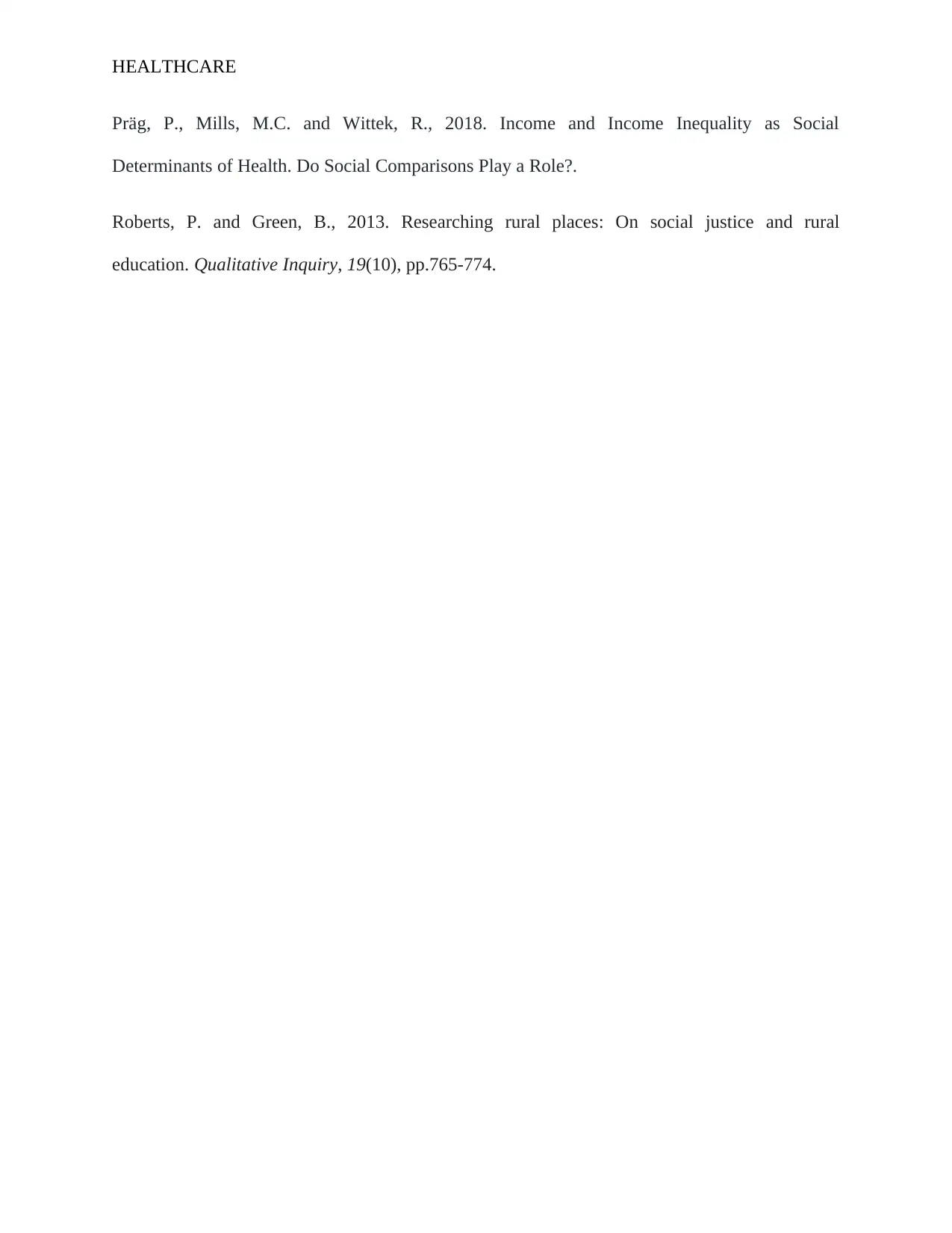
HEALTHCARE
Präg, P., Mills, M.C. and Wittek, R., 2018. Income and Income Inequality as Social
Determinants of Health. Do Social Comparisons Play a Role?.
Roberts, P. and Green, B., 2013. Researching rural places: On social justice and rural
education. Qualitative Inquiry, 19(10), pp.765-774.
Präg, P., Mills, M.C. and Wittek, R., 2018. Income and Income Inequality as Social
Determinants of Health. Do Social Comparisons Play a Role?.
Roberts, P. and Green, B., 2013. Researching rural places: On social justice and rural
education. Qualitative Inquiry, 19(10), pp.765-774.
1 out of 10
Related Documents
Your All-in-One AI-Powered Toolkit for Academic Success.
+13062052269
info@desklib.com
Available 24*7 on WhatsApp / Email
![[object Object]](/_next/static/media/star-bottom.7253800d.svg)
Unlock your academic potential
Copyright © 2020–2025 A2Z Services. All Rights Reserved. Developed and managed by ZUCOL.





